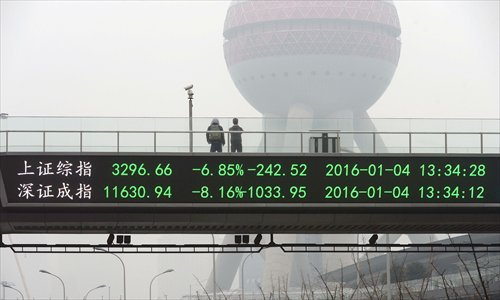No panic over market slump: expert
Slide likely caused by concerns over lifting of selling restrictions

An electronic board on an overpass in Lujiazui Financial and Trade Zone in Shanghai displays stock index information amid heavy smog on Monday. The CSI 300 Index on Monday dropped 7 percent, triggering a trading halt. Photo: Yang Hui/GT
China's 7 percent stock markets slump on Monday might have been caused by unwarranted concerns about the upcoming lifting of restriction of non-tradable shares, according to analysts.
Trading on the Shanghai and Shenzhen stock markets ended abruptly Monday after shares tumbled 7 percent, triggering the circuit-breaker mechanism on the first trading day of 2016.
The CSI 300, which tracks the performance of the 300 biggest companies traded in Shanghai and Shenzhen, was down 5 percent shortly after the afternoon session began, triggering the circuit breaker to suspend trading for 15 minutes. After trading resumed, the index continued to fall sharply, dropping by 7 percent. Trading was halted at about 1:33 pm.
Under the circuit-breaker system - which took effect Monday - the bourses must halt trading whenever the CSI 300 rises or falls by 7 percent in a single trading day.
Qian Qimin, a senior analyst at Shanghai-based Shenwan Hongyuan Securities, told the Global Times on Monday that the main reason for Monday's slump was that investors remained cautious toward the domestic stock markets, particularly as January 8 approaches. That's when a large number of non-tradable shares will be unlocked on the Chinese mainland stock markets.
The China Securities Regulatory Commission (CSRC) announced on July 8 that controlling shareholders and shareholders holding more than 5 percent of listed companies' shares will not be allowed to sell, in an attempt to stabilize the mainland stock markets, which have wildly fluctuate since mid-June.
The selling restrictions were valid for six months, and will expire on Friday.
According to a report on the Beijing-based China Economic Times on Monday, up to 1.1 trillion yuan ($169 million) worth of shares of stocks would resume trading by the end of January.
Many investors have been alarmed by expectations that those shareholders would dump their shares after January 8, and decided to sell theirs before a future markets plunge.
Li Daxiao, an analyst at Shenzhen-based Yingda Securities, told the Global Times that investors should not have panicked over the lifting of restrictions, as there was no reason that a large-scale sell-off would take place.
"At this point, listed companies' shareholders who do not want to diminish their exposure should let the public know their intention. The government should also roll out measures to stabilize the markets," he noted.
Li also pointed out that the recent mainland markets slump will not last as long as the situation around June. "I predict that A-shares will rebound shortly," he noted, adding that the Shanghai stock market is unlikely to slip below 3,000 points.
Slump a 'coincidence'
By the time blue chip A-shares trading was terminated on Monday, the benchmark Shanghai Composite Index was down 6.86 percent or 242.92 points, closing at 3,296.20 points, while the Shenzhen Component Index lost 8.2 percent or 1,038.85 points at 11,626 points.
The ChiNext Index, which tracks the country's Nasdaq-style board for growth enterprises, slipped 8.21 percent or 222.81 points to settle at 2,491.24 points.
After the stock markets resumed trading after the first suspension, they plunged faster and triggered the mechanism in a shorter time span. This was a sign that investors were worried about the markets' liquidity, and some feared that the circuit breaker would make it difficult for them to sell, Zhang Qiang, president of the Shanghai-based investment management firm Yuan Pu Investment, was quoted by the Shanghai-based International Finance News as saying on Monday.
Meanwhile, Qian said that it is just a "coincidence" that the A-shares markets experienced a dramatic slump on the first day the circuit-breaker mechanism took effect.
Shao Yu, a senior analyst at Shanghai-based Orient Securities, told the Global Times that in many overseas markets, the circuit breaker has been effective in calming the markets in cases of violent fluctuations, but whether the mechanism can exert the same influence on mainland markets remains to be seen.
He added that the mechanism might be used more frequently on domestic markets than overseas markets, as the 5 percent benchmark is relatively low considering the volatility level of domestic markets.
China's sluggish real economy is another reason for the sell-off on 2016's first trading day, Shao said.